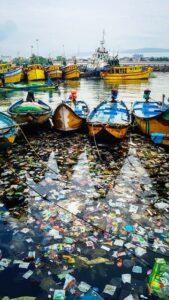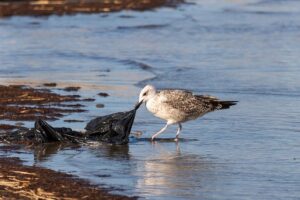Sustainable Living, News and Reviews

The Wave of Change: Confronting Plastic Waste in Our Oceans for a Sustainable Future
Plastic Pollution in Our Oceans: A Growing Crisis
This post contains affiliate links. We may earn a commission when you purchase products mentioned in the post. View our full affiliate disclosure here.
Introduction

Plastic pollution in our oceans is one of the biggest environmental issues of our time. By 2030, plastic production is expected to reach 600 million metric tons a year. This shows that our current habits of using and throwing away plastic are unsustainable.
Our oceans—once full of life—are now becoming dumping grounds for plastic waste. In this blog, we’ll dive into the depth of this problem, explore the importance of ocean conservation, and highlight how adopting sustainable habits—like going plastic-free and embracing a zero-waste lifestyle—can make a difference.
We’ll also talk about organizations like Free the Ocean, which are making a real impact by helping to clean up our oceans and raising awareness about the issue.
The Scale of Plastic Pollution
About 8 million metric tons of plastic enter our oceans every year. That’s like dumping one garbage truck full of plastic into the ocean every minute. If we continue like this, by 2050, there could be more plastic in the ocean than fish—a very scary thought.
Plastic in the ocean takes many forms:
- Macroplastics: Large items like plastic bottles, bags, and fishing nets. These items not only make our oceans look polluted, but they can also trap marine animals.
- Microplastics: Tiny plastic particles smaller than 5mm. They come from the breakdown of larger plastic items, synthetic clothing, and personal care products. Microplastics are now found in the stomachs of over 200 species of marine animals. These animals mistake them for food, which leads to poor health, reproductive issues, and even death.
Plastic pollution doesn’t just harm marine animals. It also affects humans. As fish and other sea animals eat plastic, harmful toxins build up in their bodies. When we eat seafood, we might also be consuming dangerous chemicals like BPA and phthalates. These chemicals have been linked to health issues, including hormone problems and an increased risk of cancer.
Where Does the Plastic Come From?
To solve the problem of plastic pollution, we need to understand where the plastic is coming from. Here are the main sources:
- Single-Use Plastics: Things like straws, bottles, and plastic bags. We use these items for just a short time, but they last in the ocean for hundreds of years.
- Fishing Gear: Discarded fishing nets and gear make up a large part of the plastic waste in the ocean. These “ghost nets” continue to trap and kill marine life long after they are abandoned.
- Poor Waste Management: In many countries, plastic waste isn’t properly managed. This means that a lot of plastic ends up in the ocean instead of being recycled or properly disposed of.
The Importance of Ocean Conservation
Given how serious the plastic pollution problem is, ocean conservation has never been more important. Here are some strategies we can adopt to address this crisis:
- Reduce Plastic Use: The best way to fight plastic pollution is to use less plastic in the first place. Small changes, like using a reusable water bottle, bringing your own bags to the store, and choosing glass or metal containers, can make a big difference.
- Embrace Zero Waste: A zero-waste lifestyle helps reduce plastic pollution by cutting down on the amount of waste we produce. This means buying products with minimal or no packaging, composting organic waste, and buying in bulk. For example, refill stations for personal care products and reusable containers can reduce waste.
- Support Recycling: While recycling isn’t a complete solution, it can help reduce the demand for new plastic. Some companies now make high-quality products from recycled plastic, like clothing and household items. This creates a “closed loop,” where plastic is reused instead of thrown away.
- Advocate for Change: Supporting policies that ban single-use plastics or push for better waste management can have a huge impact. Grassroots movements can influence laws that make a real difference in protecting our oceans.
- Get Involved in Clean-Ups: Joining community clean-up efforts is a great way to directly help reduce plastic waste. Organizations like Free the Ocean organize beach clean-ups, which not only remove plastic waste from shorelines but also raise awareness about the importance of protecting our oceans.
How Free the Ocean is Helping
This organization doing amazing work. Every time someone answers a trivia question on their website, they fund the removal of plastic from the ocean. It’s a simple way for anyone to get involved in ocean conservation from the comfort of their own home.
In addition to their clean-up efforts, they also raise awareness about the dangers of plastic pollution. They partner with other organizations to spread the word and encourage people to make more sustainable choices.
By supporting their initiatives, we can all contribute to reducing plastic pollution and making our oceans cleaner.
Innovations in Reducing Plastic Pollution
The plastic problem may seem overwhelming, but new solutions are being developed all the time. Here are a few exciting innovations:
- Biodegradable Plastics: Scientists are working on plastics made from natural materials that break down faster than traditional plastics. These could help reduce the amount of plastic waste that ends up in the ocean.
- Recycled Plastic Products: More and more companies are turning recycled plastic into useful products, like clothing and home goods. These products help reduce plastic waste and support a circular economy, where products are reused rather than thrown away.
- Technology to Clean the Ocean: Projects like Ocean Cleanup are using technology to collect plastic pollution from the ocean’s surface. These efforts show that technology can play a key role in cleaning up our oceans and protecting marine life.
Your Role: How You Can Help
Each of us has the power to make a difference in the fight against plastic pollution. Here’s how you can get started today:
- Choose Plastic-Free Alternatives: Start small by swapping single-use items for reusable ones. For example, you could use a reusable water bottle, glass food containers, or beeswax wraps instead of plastic.
- Support Zero-Waste Brands: Look for businesses that are committed to zero-waste practices, like using recycled materials or offering refill stations.
- Advocate for Ocean-Friendly Policies: Stay informed about plastic-related laws in your community, and support efforts to ban single-use plastics or improve waste management.
- Join Clean-Up Efforts: Volunteer for local beach clean-ups or community conservation projects. Not only will you help remove plastic waste, but you’ll also raise awareness about the problem.
- Educate and Inspire Others: Share your journey toward reducing plastic waste with friends and family. Encourage them to make small changes too, like using reusable bags or choosing plastic-free products.
Conclusion: Working Toward a Plastic-Free Future
 The fight against plastic pollution in our oceans isn’t over, but there is hope. Organizations like Free the Ocean are making a real difference by raising awareness and removing plastic from our oceans. With more people becoming aware of the issue and adopting sustainable habits, we can begin to turn the tide.
The fight against plastic pollution in our oceans isn’t over, but there is hope. Organizations like Free the Ocean are making a real difference by raising awareness and removing plastic from our oceans. With more people becoming aware of the issue and adopting sustainable habits, we can begin to turn the tide.
By reducing our use of plastic, supporting ocean conservation efforts, and pushing for better policies, we can protect our oceans for future generations.
Our oceans should be full of life, not plastic waste. Together, we can ensure they remain healthy and vibrant. Every small action counts, and by working together, we can make a big impact on the future of our planet.
It’s time to take responsibility and ride the wave of change. Let’s make every effort to protect the world we live in, starting with our oceans.